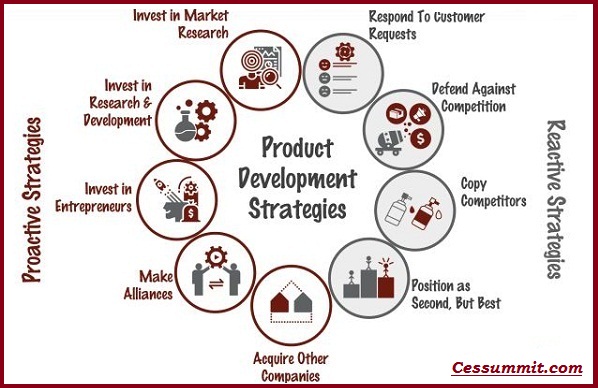
Optimizing the Product Development Process in an Industry
Optimizing the Product Development Process in an Industry – This article on Optimizing the Product Development Process in an Industry. In today’s rapidly evolving industry landscape, optimizing the product development process has become a critical undertaking for businesses seeking a competitive edge. The journey from concept to market-ready product is fraught with challenges, from resource allocation and time management to aligning customer expectations with technological advancements.
Recognizing the significance of streamlining and enhancing the product development process, companies are employing innovative strategies, leveraging advanced technologies, and fostering a collaborative environment to drive efficiency, reduce costs, and deliver superior products to the market. By embracing a holistic approach to product development optimization, industries can position themselves at the forefront of innovation and meet the ever-growing demands of their customers.
Contents
- 1 Post Focus:
- 2 Understanding the Current Process
- 3 Strategies for Optimizing the Product Development Process
- 3.1 Foster Cross-Functional Collaboration:
- 3.2 Implement Agile Methodologies:
- 3.3 Utilize Project Management Tools:
- 3.4 Conduct Regular Reviews and Iterations:
- 3.5 Embrace Rapid Prototyping and Testing:
- 3.6 Streamline Decision-Making Processes:
- 3.7 Continuously Invest in Skill Development:
- 3.8 Conclusion
- 3.9 Optimizing the Product Development Process in an Industry
- 4 Streamlining the Process
- 5 Incorporating Customer Feedback
- 6 Embracing Technology and Automation
- 6.1 Adopting advanced software tools for design and development:
- 6.2 Leveraging artificial intelligence and machine learning:
- 6.3 Implementing automated testing and quality assurance processes:
- 6.4 Exploring rapid prototyping and 3D printing technologies:
- 6.5 Optimizing the Product Development Process in an Industry
- 7 Continuous Improvement and Learning
- 8 Case Studies and Examples
- 8.1 Highlighting successful optimization stories from the industry:
- 8.2 Showcasing companies that have improved their product development process:
- 8.3 Sharing real-world examples of the benefits of optimization:
- 8.4 Optimizing the Product Development Process in an Industry
- 8.5 Read More:
- 8.6 Summing-Up: Optimizing the Product Development Process in an Industry
- 8.7 Share this:
- 8.8 Like this:
Post Focus:
Why is this post a must read? This post “Optimizing the Product Development Process in an Industry” is a must-read for several reasons. Here are a few key points:
Competitive Advantage:
In today’s fast-paced business environment, companies need to continually innovate and bring new products to market efficiently. By optimizing the product development process, organizations can gain a competitive edge by delivering products faster, reducing costs, and improving quality. This book provides valuable insights and strategies to achieve these goals.
Efficiency and Cost Savings:
Inefficient product development processes can result in wasted time, resources, and increased costs. This book explores various methodologies, tools, and techniques to streamline the product development process, eliminate bottlenecks, and enhance overall efficiency. Implementing these strategies can lead to significant cost savings for companies.
Optimizing the Product Development Process in an Industry
Quality Improvement:
Product quality is of utmost importance for customer satisfaction and retention. This book offers guidance on optimizing the product development process to ensure that quality is built into the product from the beginning. It covers topics such as design for manufacturability, risk assessment, prototyping, and testing, enabling companies to deliver high-quality products that meet customer expectations.
Collaboration and Communication:
Successful product development requires effective collaboration and communication among cross-functional teams, stakeholders, and suppliers. This book provides insights into fostering collaboration, improving communication channels, and managing interdependencies within the product development process. It highlights the importance of teamwork, knowledge sharing, and leveraging technology to enhance collaboration.
Optimizing the Product Development Process in an Industry
Adaptability and Innovation:
Industries are constantly evolving, and companies must be adaptable and innovative to stay ahead. This book emphasizes the importance of agility in the product development process, enabling companies to respond quickly to market changes and customer feedback. It explores methodologies like Agile and Lean, which promote iterative development, experimentation, and continuous improvement.
Case Studies and Practical Examples:
To illustrate the concepts and strategies discussed, the book includes real-world case studies and practical examples from various industries. These examples provide valuable insights into how companies have successfully optimized their product development processes and achieved tangible results. Readers can learn from these experiences and apply the lessons to their own organizations.
Optimizing the Product Development Process in an Industry
In conclusion, “Optimizing the Product Development Process in an Industry” is a must-read for professionals involved in product development, project management, and innovation. It offers practical guidance, best practices, and real-world examples to help companies streamline their processes, improve efficiency, enhance quality, foster collaboration, and drive innovation. By implementing the strategies outlined in this book, organizations can gain a competitive advantage and achieve sustainable growth in their respective industries.

Optimizing the Product Development Process in an Industry
The product development process refers to the series of steps taken to create a new product, from concept to market launch. It typically involves activities such as idea generation, market research, design, prototyping, testing, and production. Each industry may have its specific variations, but the fundamental stages remain similar.
Optimizing the product development process is crucial in the industry for several reasons. First, it reduces time-to-market, allowing companies to bring products to customers faster and gain a competitive advantage. Second, it helps minimize costs by streamlining workflows and reducing inefficiencies. Third, optimizing the process improves product quality, leading to greater customer satisfaction and loyalty.
The purpose of this post is to provide strategies for optimizing the product development process. By implementing these strategies, companies can enhance their efficiency, reduce costs, and deliver high-quality products in a timely manner.
Optimizing the Product Development Process in an Industry
Understanding the Current Process
To optimize the product development process, it’s essential to evaluate the existing workflow. This involves examining each stage and understanding how activities and tasks are currently executed. This evaluation can help identify areas for improvement and determine potential bottlenecks or inefficiencies.
Identifying bottlenecks and inefficiencies is crucial in streamlining the process. These could be delays in decision-making, lack of collaboration between teams, inadequate resource allocation, or ineffective communication channels. By pinpointing these issues, companies can address them and make the necessary improvements.
Collecting data and feedback from stakeholders is essential for understanding the strengths and weaknesses of the current process. Stakeholders may include product managers, designers, engineers, manufacturing teams, marketing personnel, and even customers. Gathering feedback through surveys, interviews, or focus groups can provide valuable insights into areas that need improvement and help in designing effective strategies.
Optimizing the Product Development Process in an Industry
Strategies for Optimizing the Product Development Process
Foster Cross-Functional Collaboration:
Encourage collaboration between different teams involved in the product development process. Promote open communication channels, establish regular meetings, and encourage knowledge sharing. This collaboration facilitates a more holistic approach to product development, reduces errors, and speeds up decision-making.
Implement Agile Methodologies:
Agile methodologies, such as Scrum or Kanban, provide frameworks for iterative and incremental development. These methodologies emphasize flexibility, adaptability, and continuous improvement. By implementing agile practices, teams can respond quickly to changes, prioritize tasks effectively, and deliver value in shorter cycles.
Optimizing the Product Development Process in an Industry
Utilize Project Management Tools:
Implementing project management tools can streamline the product development process. These tools help in tracking tasks, managing timelines, allocating resources, and monitoring progress. They enhance coordination among team members and provide a centralized platform for communication and documentation.
Conduct Regular Reviews and Iterations:
Regularly review the progress of the product development process and identify areas for improvement. Conduct post-mortems after each project to evaluate successes and failures objectively. Incorporate the lessons learned from these reviews into future iterations of the process to continually refine and optimize it.
Optimizing the Product Development Process in an Industry
Embrace Rapid Prototyping and Testing:
Adopting rapid prototyping techniques allows for quick validation of product ideas and reduces the risk of investing in the wrong direction. Test prototypes early and gather feedback from users to make informed design decisions. This iterative approach saves time, reduces rework, and ensures that the final product meets customer needs.
Streamline Decision-Making Processes:
Delays in decision-making can significantly impact the product development process. Establish clear decision-making frameworks, delegate decision-making authority to appropriate individuals or teams, and define decision criteria. Streamlining decision-making ensures faster progress and minimizes bottlenecks.
Optimizing the Product Development Process in an Industry
Continuously Invest in Skill Development:
Encourage ongoing skill development and training for employees involved in the product development process. Stay updated with industry trends, new technologies, and best practices. Investing in skill development enhances the capabilities of the team and fosters innovation and efficiency.
Conclusion
Optimizing the product development process is crucial for companies aiming to stay competitive in the industry. By understanding the current process, identifying bottlenecks, and collecting feedback, organizations can implement effective strategies to streamline workflows, improve collaboration, and deliver high-quality products efficiently. Through continuous improvement and embracing innovative approaches, companies can gain a significant edge in the market.
Optimizing the Product Development Process in an Industry
Streamlining the Process
Establishing clear goals and objectives:
Clearly define the goals and objectives of the product development process. This ensures that everyone involved understands the desired outcomes and can align their efforts accordingly.
Defining roles and responsibilities:
Clearly define the roles and responsibilities of each team member involved in the product development process. This eliminates confusion, ensures accountability, and promotes efficient collaboration.
Implementing agile methodologies:
Agile methodologies, such as Scrum or Kanban, promote flexibility, adaptability, and continuous improvement. They enable teams to work in iterative cycles, prioritize tasks effectively, and respond to changes efficiently. Agile methodologies foster transparency, collaboration, and faster delivery of value.
Optimizing the Product Development Process in an Industry
Utilizing project management tools and software:
Project management tools and software help streamline the product development process by providing a centralized platform for task management, resource allocation, and progress tracking. These tools facilitate efficient communication, documentation, and collaboration among team members.
Encouraging collaboration and communication:
Foster a culture of collaboration and open communication within the product development teams. Encourage regular meetings, knowledge sharing sessions, and cross-functional collaboration. Effective communication ensures that information flows smoothly, bottlenecks are identified and resolved promptly, and everyone is aligned towards the common goal.

Optimizing the Product Development Process in an Industry
Incorporating Customer Feedback
Gathering customer insights and preferences:
Engage with customers through surveys, interviews, focus groups, or user testing sessions to gather valuable insights into their preferences, pain points, and expectations. This customer feedback serves as a foundation for designing and refining the product to meet their needs effectively.
Conducting market research and competitor analysis:
Conduct thorough market research to understand market trends, customer demands, and competitor offerings. Analyze the competitive landscape to identify gaps and opportunities. This knowledge allows for informed decision-making and helps position the product strategically in the market.
Optimizing the Product Development Process in an Industry
Implementing iterative design and prototyping:
Adopt an iterative approach to design and prototyping. Develop multiple iterations of the product, incorporating customer feedback and making incremental improvements at each stage. This iterative process allows for early validation, reduces the risk of developing a product that doesn’t meet customer expectations, and saves time and resources.
Regularly testing and validating product concepts:
Continuously test and validate product concepts throughout the development process. Conduct usability tests, beta testing, or pilot programs to gather feedback and validate the product’s functionality, user experience, and market fit. Regular testing and validation ensure that the product meets customer needs and aligns with market expectations.
By incorporating these strategies into the product development process, companies can optimize their workflows, improve collaboration, and create products that resonate with customers and succeed in the market.
Optimizing the Product Development Process in an Industry
Embracing Technology and Automation
Adopting advanced software tools for design and development:
Utilize industry-specific software tools that enhance the design and development process. These tools can range from computer-aided design (CAD) software to simulation and analysis tools, enabling faster and more accurate product development.
Leveraging artificial intelligence and machine learning:
Explore the applications of artificial intelligence (AI) and machine learning (ML) in product development. AI and ML algorithms can assist in tasks such as data analysis, predictive modeling, and optimization, leading to improved decision-making and efficiency.
Optimizing the Product Development Process in an Industry
Implementing automated testing and quality assurance processes:
Introduce automated testing and quality assurance processes to ensure product reliability and efficiency. Automated testing tools can perform repetitive tests quickly and accurately, identifying defects and reducing human error.
Exploring rapid prototyping and 3D printing technologies:
Rapid prototyping and 3D printing technologies enable the creation of physical prototypes quickly and cost-effectively. These technologies allow for faster iteration, validation, and refinement of product designs, reducing time-to-market.
Optimizing the Product Development Process in an Industry
Continuous Improvement and Learning
Establishing a culture of innovation and learning:
Foster a culture that encourages innovation, creativity, and continuous learning. Encourage employees to explore new ideas, experiment with different approaches, and embrace change. Emphasize the importance of staying updated with industry trends and emerging technologies.
Conducting post-mortem analyses of completed projects:
After completing each project, conduct post-mortem analyses to evaluate the successes, challenges, and lessons learned. Identify areas for improvement and develop strategies to address them in future projects. Encourage honest feedback and a blame-free environment to facilitate open discussions.
Identifying areas for improvement and implementing changes:
Continuously monitor and evaluate the product development process to identify areas that can be improved. This includes analyzing metrics, seeking feedback from stakeholders, and staying updated with industry best practices. Implement changes and adjustments to optimize the process and enhance overall efficiency.
Optimizing the Product Development Process in an Industry
Encouraging knowledge sharing and professional development:
Encourage knowledge sharing among team members through regular meetings, workshops, and internal training programs. Provide opportunities for professional development, such as attending conferences, webinars, or specialized training courses. By investing in the growth and development of employees, companies can foster a culture of continuous improvement.
By embracing technology and automation, as well as promoting a culture of continuous improvement and learning, companies can enhance their product development process, increase efficiency, and drive innovation, ultimately leading to the creation of successful and market-leading products.
Optimizing the Product Development Process in an Industry
Case Studies and Examples
Highlighting successful optimization stories from the industry:
Showcase examples of companies that have successfully optimized their product development process. Discuss how they identified bottlenecks, implemented strategies for improvement, and achieved significant results, such as reduced time-to-market, increased efficiency, or improved customer satisfaction.
Showcasing companies that have improved their product development process:
Highlight specific companies that have undergone a transformation in their product development process. Share their journey, including the challenges they faced, the strategies they implemented, and the positive outcomes they achieved. This can inspire readers and provide real-world examples of successful optimization.
Optimizing the Product Development Process in an Industry
Sharing real-world examples of the benefits of optimization:
Share specific examples of companies that have reaped the benefits of optimizing their product development process. Discuss how optimization led to increased innovation, cost savings, improved product quality, or a competitive advantage in the market. These examples can illustrate the tangible and positive impact of optimization.

Optimizing the Product Development Process in an Industry
Read More:
- Blockchain Technology: The Future of Financial Services and Banking
- Unlocking Competitive Advantage for Best Practices in Product Development
- Leveraging Blockchain for Secure and Transparent Digital Identity Management
- The Role of Blockchain Technology in Cryptocurrency
- The Potential Benefits of Adopting E-Naira in Business Operations
- The Role of E-Naira in Fostering Financial Inclusion for Business Owners
- E-Naira and Digital Marketing in Nigeria
- How to Write Winning Proposals that Close Deals
- How to Raise Funds for Your Project by Crowdfunding
- Cessummit.com Services Offerings: What we do & How
- Profitable Business Idea
Summing-Up: Optimizing the Product Development Process in an Industry
Summarize the key strategies and concepts covered in the post, such as evaluating the current process, incorporating customer feedback, embracing technology and automation, and fostering a culture of continuous improvement.
Reinforce the importance of optimizing the product development process for companies to stay competitive, reduce costs, deliver high-quality products, and meet customer expectations in a timely manner.
Optimizing the Product Development Process in an Industry
Encourage readers to take action and implement the strategies discussed in the post. Emphasize that optimizing the product development process requires a proactive approach and a commitment to continuous improvement.
Highlight the long-term benefits that companies can achieve by streamlining their product development process, such as increased efficiency, improved innovation, higher customer satisfaction, and a stronger market position. Emphasize that optimization is an ongoing journey and that investing time and effort into the process can yield significant rewards.






